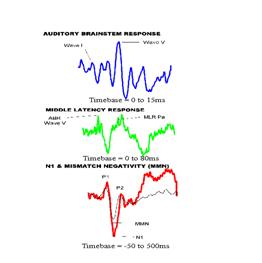|
Event-related
potentials (ERPs) are brain responses time-locked to some
"event". This event may be a sensory stimulus (such as a visual
flash or an auditory sound), a mental event (such as recognition of a
specified target stimulus), or the omission of a stimulus (such as an
increased time gap between stimuli).
Auditory evoked potentials (AEPs) are a subclass of ERPs. For AEPs, the
"event" is a sound. AEPs (and ERPs) are very small electrical
voltage potentials originating from the brain recorded from the scalp in
response to an auditory stimulus (such as different tones, speech sounds,
etc.). The AEPs that are recorded from the top of the head originate
from structures within the brain (e.g., the auditory cortex, the auditory
brainstem structures, the auditory VIIIth cranial nerve). They are very low
in voltage: from 2-10 microvolts for cortical AEPs to much less than 1
microvolt from the deeper brainstem structures. Their low voltage combined
with relatively high background electrical noise requires the use of highly
sensitive amplifiers and computer averaging equipment
The figure to the left shows several auditory ERPs/AEPs (plotted with
positivity upwards).
The Auditory
Brainstem Response ("ABR"; 1.5-15 ms post
stimulus), which originates in the VIIIth cranial nerve (waves I and II)
and brainstem auditory structures (wave V: region of lateral lemniscus and
inferior colliculus).
The Middle
Latency Response ("MLR", 25-50 ms
poststimulus), includes waves Na (negative wave following ABR wave V,
originates in upper brainstem and/or auditory cortex) and Pa (positive wave
at about 30 ms, originates in the auditory cortex bilaterally).
The "Slow"
cortical auditory ERPs, which include the P1-N1-P2 sequence (50-200 ms
poststimulus; originating in auditory cortex). N1 is the large negative
wave that occurs about 80-100 ms after the stimulus. It originates
primarily in the auditory cortex bilaterally. In the figure to the left, it
is the large negative wave seen both in the response to the
"standard" (black line) and the "deviant" (or oddball;
red line) stimuli.
The "Late"
cortical auditory ERPs, especially the Mismatch Negativity ("MMN";
beginning around the time of N1 and later).
The MMN is a response reflecting detection by the brain of a change in the
stimulus. In the figure to the left, the MMN is the increased negativity
seen in the response to the deviant or change stimuli (red line), at about the
time of N1 and a little later. Other "late" ERPs, not present in
these waves, include "N2b" and "P3b", which are
cortical ERPs which are not specifically from auditory structures
(see Cortical
ERPs below).

|